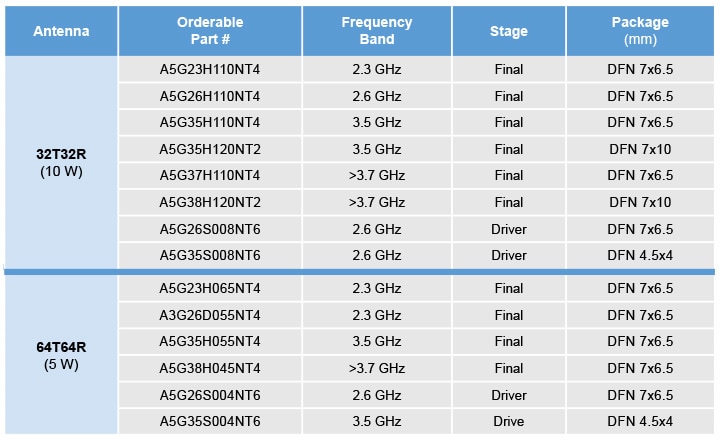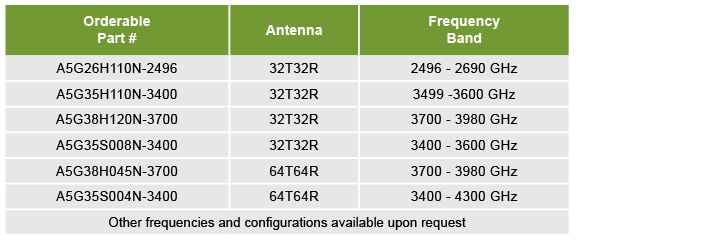Demand for mobile data is going to skyrocket in the next few years. In a
December 2021
press release, ABI Research, a global technology intelligence firm, predicted increases in
mobile data traffic reaching to 1331 exabytes worldwide in 2025, up from 23
exabytes in 2019 – a staggering CAGR of 97%.
Wireless carriers are already heavily invested in 5G and its continued growth.
5G is the only way to deliver the increased system capacity, data throughput
and coverage needed to meet future demand. But predictions of explosive growth
put more pressure on the market. Today’s network operators need fast,
efficient ways to deploy 5G, while also minimizing the impact on current
services and protecting future operating expenses.
Importance of mMIMO
One of the 5G techniques that network operators use to support increased
traffic is an antenna format called Massive MIMO (mMIMO). This is a hardware
configuration that uses an array of multiple antenna elements to transmit
multiple data streams in a desired direction. Deploying mMIMO increases
spectrum efficiency—particularly when mMIMO is used in combination with
beamforming, a software technique that helps direct energy and reduce
interference. The result is faster connections and better end-user
experiences, even as demand for mobile traffic goes up.
“As 5G deployments continue to expand globally, network operators need to
extend their coverage while maintaining performance. By offering twice the
power in the same package size, NXP enables RF engineers to create base
stations that are smaller, lighter and easier to deploy and conceal in urban
and suburban areas.”
Jim Norling, Vice President and General Manager, High Power Solutions,
Radio Power, NXP
Higher performance from existing sites makes mMIMO a key enabler of 5G, and
that means demand for mMIMO solutions will increase in line with demand for
mobile traffic. The December press release from ABI Research reflects this by
predicting that mMIMO deployments will reach 32 million by 2026, up from less
than 2 million in 2020.
Generally speaking, any mMIMO solution that uses an array larger than 8T8R (8
transmission, 8 reception) qualifies as “massive” – solutions range from
16T16R to 32T32R and 64T64R. The 16T16R format offers limited capacity and is
primarily used for 5G coverage in rural areas. Since more 5G rollouts have
focused on more densely populated areas in today’s environment, the 32T32R and
64T64R are the two most widely used.
64T64R Versus 32T32R mMIMO
 Massive MIMO 5G Coverage in Dense Urban Areas
Massive MIMO 5G Coverage in Dense Urban Areas
In areas where deployments of 5G have focused on very densely populated urban
environments, such as high-rise apartment buildings and city centers, the
64T64R mMIMO format is preferred. That’s because 64T64R offers the highest capacity potential and offers the biggest possible
gains in coverage and spectral efficiency.
64T64R technology represents the cutting-edge upper limit of what’s possible.
These solution improvements come at a high price in terms of energy
consumption, size and weight. As technology
advances and software improvements are ongoing in energy efficiency and
production volumes, prices are likely to come down over time as well.
Once you move beyond the city center, to less densely populated areas with
lower rise buildings, 32T32R becomes a compelling solution. It’s cheaper and
more compact than that of 64T64R, but offers similar levels of output power.
Network operators will use a mix of mMIMO configurations to meet their goal.
With more subscribers using more data, the goal for most network operators is
to increase capacity but limit their total investment. In very densely
populated areas that require maximum capacity and coverage, 64T64R will remain
the best option. But in less densely populated urban and suburban areas, where
subscribers can make do with lower capacity and coverage, 32T32R will
dominate.
Looking for Greener Options
Deploying mMIMO is an attractive option in terms of investment cost. mMIMO
reuses existing cell sites, leverages the multi-band capability already built
into 4G and is a quick way to expand coverage, deliver faster service and add
subscribers.
At the same time, there is always the question of power consumption. With
mMIMO, the amount of electricity needed per byte of data transmitted goes
down, since you’re sending more data at once, but the base station itself
consumes more power. As a whole, the average 5G base station can consume as
much as three times the amount of energy as a 4G base station for the same
amount of coverage. Increased energy consumption means higher operating costs
and has negative implications for climate change.
The search for greener options means mMIMO chipsets need to be smaller,
lighter and consume less energy than their predecessors. Semiconductor
manufacturers are optimizing hardware and using advanced algorithms to improve
mMIMO performance. That includes optimizing beamforming techniques, to make
better use of weight factors and adjustments in horizontal and vertical spread
of transmitted signals. This is so there’s less interference, higher spectral
efficiency and it’s easier to support large groups of users in a given area.
Artificial intelligence has a role to play as well. AI algorithms can be used
to switch off various elements in the network when traffic is light, and then
re-engage them when traffic increases. Given to the different levels of
traffic, AI can also be used to monitor the consumer experience, and find the
best balance between energy consumption and network performance. Also, as AI
continues to gather data, algorithms will be able to predict data traffic more
accurately for even greater energy efficiency.
The NXP Approach
At NXP, we understand that delivering mMIMO is about more than just increasing
the number of antennas. It takes the highest levels of design expertise,
process know-how and deployment experience. As a longtime leader in cellular
technology, we leverage decades of R&D and real-world operating experience to
our mMIMO product portfolio.
Having recently introduced our
new series
of RF power discrete 32T32R solutions, we now offer a portfolio that supports
32T32R and 64T64R operations. Housed in the same size package as our 64T64R
solutions, our 32T32R solutions offer twice the power and expands coverage
beyond ultra-dense urban areas. Moving 5G into less dense urban and suburban
areas, 32T32R solutions offers a wider coverage area compared to 64T64R
solutions. The result is a smaller, lighter weight 5G radio that is easy to
deploy in urban and suburban areas.
 Table 1: 32T32R and 64T64R Portfolio Features
Table 1: 32T32R and 64T64R Portfolio Features
NXP increases efficiency of 5G mMIMO systems by producing them in our own,
highly linearizable, Gallium nitride (GaN) manufacturing facility. Our
optimized GaN process increases integration for a more compact design. In most
cases, our GaN delivers twice the power in the same package, which enables
smaller, lighter 5G radios that are easier to deploy.
NXP mMIMO solutions, along with our fully integrated modules, offer maximum
design flexibility and meet fastest time-to-market requirements.
NXP’s 5G Access Edge Portfolio
From antenna to processor, NXP offers a robust portfolio of technologies for
accelerating deployments. We deliver optimized performance and security for
infrastructure, industrial and automotive applications. Our portfolio includes
our Airfast family of RF power solutions, and our Layerscape family of
multicore processors for wireless data links, fixed wireless access and
small-cell devices.
Take the Next Step
Learn more about
DMS
and explore our latest mMIMO discrete products, along with evaluation boards.
Portfolio Details
 Table 2: Our latest 5G Massive MIMO discrete product offerings
Table 2: Our latest 5G Massive MIMO discrete product offerings
 Table 3: Our latest 5G Massive MIMO evaluation board offerings
Table 3: Our latest 5G Massive MIMO evaluation board offerings
Furthermore, you can learn more about how NXP improves mMIMO and ehances the
next generation of cellular by visiting our dedicated
5G site.








